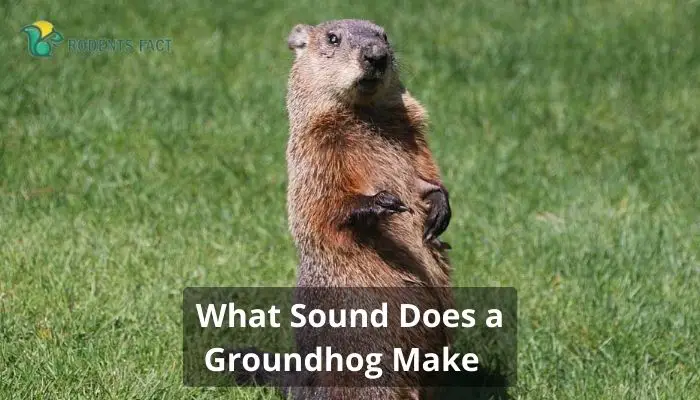What Sound Does a Groundhog Make?| Surprising Meaning of Different Sounds
The groundhog, often called a woodchuck, is a nocturnally quiet creature that makes a lot of noise during the day. Groundhogs like communicating via various chirps and grunts that they use when aroused. But what sound does a groundhog make?
The groundhog is quite vocal while defending itself, making sounds like hissing, shrieking, and the sound of teeth chattering. The woodchuck is so proactive that it whistles to its fellow woodchucks to warn them of impending danger.

The groundhog avoids detection by remaining silent for most of the day and night, making just the slightest of sounds for self-defense and necessary communication.
The groundhog’s call is a high-pitched whistle or scream that travels up to 500 yards. Some have compared these cries to a quacking noise, while others have said they resemble a shout. The groundhog’s voice is used for underground communication and during mating rituals.
What Sounds Does Groundhog Make?
A groundhog may make many sounds, but a warning grunt and a challenge bark are the most common. A groundhog gives a brief, low warning grunt that it repeats many times.

When you hear this sound, other groundhogs will know you are getting close to their burrow, and they will run for cover.
Though similar to a grunt in length, the challenged bark is more akin to a snarl. Useful in situations when one groundhog threatens another in a battle for territory. This occurs, for example, when one male attempts to colonize the burrow of another.

In addition to their trademark “chattering,” groundhogs are known to produce sounds like “clicking their teeth together” and “chattering” when they are agitated. This often occurs after consuming one of their preferred diets, which includes insects, worms, and other plants.
Additional Read: Do you want to fill the chipmunk holes?
3 Types of Sounds Groundhogs Make
Groundhogs can be heard making various noises, from whistling to grunting to chirping to screeching to chuckling to teeth chattering. The groundhog makes various sounds depending on its disposition.

Chirping
The groundhog’s primary method of communicating is by chirping. From food to shelter, a groundhog’s requirements may be conveyed via its chirps.
Grunting
When the groundhog is pleased or aroused, it lets out a grunt. The groundhog often makes this sound while enjoying an activity, like eating, interacting with others, or basking in the sun.

Whistling
Using a whistle as a deterrent is quite frequent. When a woodchuck hears a predator in the area, it will whistle to alert the rest of the colony.
In doing so, they both drive away potential predators and notify other groundhogs in the area that danger is there.
Sounds of Baby Groundhog
Baby groundhogs often emit squeaking sounds to help them find their way around, particularly when they are taken outside their burrows. Young groundhogs are unable to vocalize their requirements. Therefore they make a high-pitched whine while calling out for their moms.

Why Do Groundhogs Scream?
The groundhog’s distinctive calls may be heard from great distances. They are capable of making an impressive variety of noises.

The groundhog’s scream is the fiercest and most agitated of its several calls. Not only do groundhogs scream, but they also produce a variety of other sounds, such as barking, growling, and hissing. These vocalizations are used in many different contexts by these individuals.
When a groundhog is startled or frightened, it often hears a scream. Possible examples include coming into contact with a person or hearing a loud noise out of the blue. Another possible function of the cry is to warn other groundhogs in the area to keep their distance.
Why do groundhogs chirp, and what is the significance of their screaming? The groundhog chirps to communicate with its family and attract the other sex. Chirping sometimes indicates distress, as when they are threatened or injured.
Roughly three weeks after birth, they begin their incessant chirping, which lasts until they hit adulthood at around four months.
The groundhog’s distinct whistling has earned it the title of Pennsylvania’s state animal.
Groundhog Sounds At Night
A groundhog’s nighttime calls often sound like a sequence of chirps or squeaks and have been likened to those of a mouse. When looking for food or attempting to locate a partner, the animals communicate using these noises.

This communication may also alert other group members of danger or an oncoming predator or human.
What about groundhog noises, not just those they emit at night? A groundhog could make a purring sound, but it might also chatter or bark.
The noises made by groundhogs span a broad spectrum. They let out quick, high-pitched barks in times of danger or distress. These noises, which are audible day and night, serve as a warning to other groundhogs.
Most predators are driven from a groundhog’s area by the sound of its barking.
When two groundhogs are vying for territory, they may make clicking noises to communicate. Groundhogs, like cats, may be heard making gentle purring noises when they are satisfied or joyful.
Happy Groundhogs Sounds
A groundhog will produce a pleasing grunting sound if they are happy. The noise is a low, resonant chortle that sounds like a human laughing. Its joyfulness causes it to breathe rapidly from and to its nostrils, producing the noise. The noise is often heard in clusters and has a relatively high pitch.

When groundhogs greet one another with their unique Eskimo kisses, it is customary for them to grunt at each other. One of their unique kisses is tender stroking of noses and mouths. As they do so, they make a soft and friendly grunting noise. One of their memorable kisses is tender stroking of noses and mouths.
Groundhog Warning Call
Before attacking, groundhogs often provide warning cries to nearby animals. They have formidable defensive mechanisms that usually keep them safe from predators.

The groundhog’s teeth-chattering is an effective warning signal.
A groundhog’s most vigorous defense against predators is a set of chattering teeth. It serves as a warning to other animals that the groundhog’s teeth are dangerously sharp. That’s why the groundhog is considered dangerous to some people.
When groundhogs are startled, they make a sound similar to gnashing teeth. Their warning cry consists of a passive, uncontrolled chattering of teeth, not threatening to gnash teeth.
Panicked Calls of a Groundhog
Groundhogs often whistle when they are in danger. They emit this roar when they are in mortal danger, or sense danger is imminent. Groundhogs in the vicinity may be alerted to leave using a warning whistle. When frightened, groundhogs make loud squeals and screams.

Groundhogs Growling Sounds
Groundhogs may sometimes let off a low, deep growl when agitated or attempting to frighten other animals. The groundhog does not only try to scare away rival animals by growling at them.

The groundhog also makes loud shrills. In most cases, groundhogs will use them to fend off irate predators.
Growl
Their roar resembles a murmured warble, and it is highly frightening to some creatures. Compared to the growls of canids and foxes, these sounds could not be more unlike. They are warbles that look like a leaner or swifter animal.
Shrill
The groundhog protects itself against huge predators by making a high-pitched shrill noise. The groundhog’s high-pitched, piercing cry serves as a warning to would-be predators.
Since the shrill is so loud, if the groundhog cannot scare away its attacker, it usually has enough time to get away while the sound preoccupies the predator.
How to Recognize Groundhog Sounds?
As such vocal animals, groundhogs’ calls are easy to pick out and recognize; some sounds even allude to the animal’s namesake.

Keep an Eye
Keep an eye on the animal while it creates the noise. While chowing down, woodchucks produce chuck-chucking sounds. This noise is what first drew attention to the woodchuck.
Listen for the Shift in Tone
Listen for the shift in tone that occurs when the animal is startled. In the event of impending danger, a woodchuck will whistle loudly and high-pitched to warn other animals.
This high-pitched whistle is followed by a more subdued one when the animal returns to its burrow. The woodchuck’s unique calls led to another of its common names: whistling pig.

Squeals Indicate an Injured Groundhog
Woodchuck squeals are generally a sign that the animal has been hurt or trapped by a predator, so you should proceed with care if you hear one. This noise is also produced by woodchucks when they are in discomfort or when they are fighting with one another.
Differentiate Between Conversation and Grooming Sounds
Know the difference between talking sounds and the grinding or grating of grooming noises. Woodchucks, like other rodents, have ever-evolving sets of teeth. The woodchuck grinds its teeth regularly to maintain them at a manageable length; otherwise, it would have problems eating and grooming.
Listen for Low Barking
Keep your ears open for a soft, low barking sound. Scientists have not determined the origin of this noise.
Listen for Hiss
The hiss of a woodchuck means you should immediately cease your current activity. This noise is usually used to defend against or attack potential predators.
A groundhog making whistle cal:
Frequently Asked Questions
1. Do Groundhogs Growl?
When disturbed, groundhogs whistle to alert others. Angry groundhogs hiss, shriek, or growl.
2. Why Do Groundhogs Squeal?
When fighting, hurt, or captured, groundhogs shriek. Low barks and teeth-grinding noises are also familiar.
3. What Sound Do Groundhogs Make When Warning Others of Danger?
Whistle-pig comes from groundhogs’ propensity to whistle whenever they feel intimidated.
4. Are Groundhogs Aggressive?
Burrowing causes structural deterioration. Groundhogs, commonly called woodchucks, are aggressive and hard to remove. These rats build tunnels in grasslands and destroy plants.
Final Words
Now you know what sound does a groundhog make. Groundhogs create several noises. The groundhog’s scream is loud and unique.
The groundhog’s squeak warns animals of danger. The groundhog makes noises to communicate or for fun.
The groundhog’s sound is louder and more distinct than a dog whistle. Its scream comprises fast-repeated notes.





I observe a groundhog that lives in my area. I sometimes put a small amount of near expired produce out for her. She knows where to look for it. (There are no delicious gardens to raid here and she is far from any buildings). She has a new quite small baby this spring and is teaching how to forage but the baby has not yet approached the rock where I sometimes put produce. The rock is about 15′ from the burrow.
Today I put 5 very small sad tomatoes still on the vine. She came and ate one then turned toward the burrow where the baby was watching. She opened her mouth very wide and made a sound. I cannot hear her as I’m indoors. She then ate another tomato. She then howled again, facing the baby. She did it one more time, always turning to face the burrow. Usually she faces toward my home where I think she knows I am watching her.
I wish I could’ve heard her but I have to think she was telling baby to come for a tomato. She did eat all 5. Last week I twice saw her collecting tufts of grass in her mouth and taking them to the burrow. So I wondered if she would bring something to the baby but she did not.
I live in quite an urban area but have a small stand of trees on a steep hill behind my home where she has had a burrow for a few years. We live in harmony and my contribution to her diet is very small.